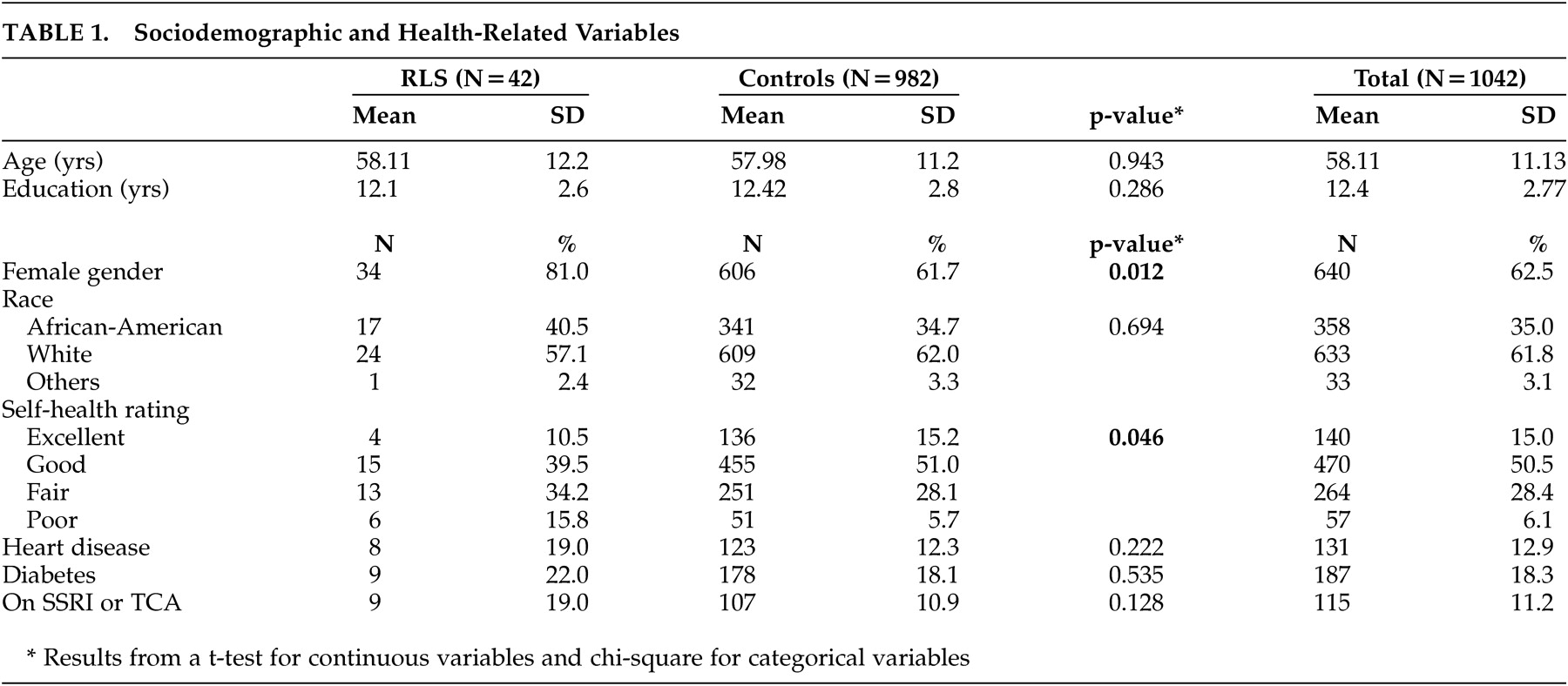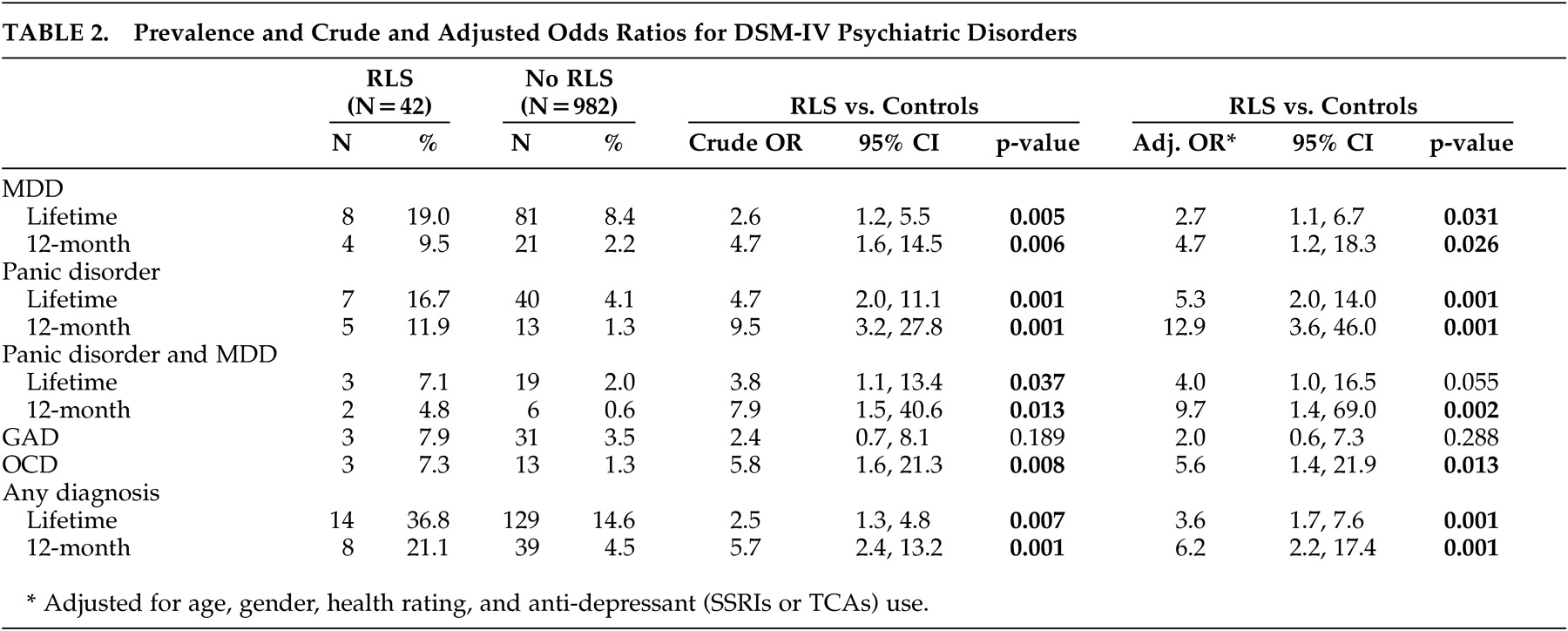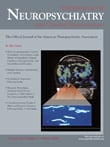R estless Legs Syndrome (RLS) is a common yet underrecognized neurological, sensorimotor disorder that affects 5% to 10% of the general adult population.
1 Several population- and clinic-based studies have reported higher depression and anxiety ratings in individuals with restless legs syndrome than without.
2 Due to reliance on mood and anxiety rating scales with questionable validity, however, clinical significance of the previous reports has remained disputable.
Recently, the Baltimore Epidemiologic Catchment Area (ECA) 23-year follow-up study assessed 1071 participants for restless legs syndrome symptoms by a seven-item questionnaire and assigned psychiatric diagnoses according to responses on the Diagnostic Interview Schedule (DIS).
3 We examined the cross-sectional association between restless legs syndrome and DSM-IV major depressive disorder and panic disorder in this cohort.
Sample
The Epidemiologic Catchment Area program, supported by the National Institute of Mental Health (NIMH), is a community-based study of the prevalence of psychiatric disorders and is described elsewhere in detail.
4 At the Baltimore site, the original sample consisted of 3481 residents selected by probability sampling methods from three catchment areas in East Baltimore in 1981. A total of 1920 out of 3481 original participants were reinterviewed during Wave III in 1993. The study sample consists of 1071 participants (75% of the surviving participants of Wave III) who continued to participate in Wave IV in 2004.
Diagnosis of RLS
The symptoms of restless legs syndrome were assessed during Wave IV on a seven-item RLS Questionnaire, which was adapted and expanded from the previously validated, three-item restless legs syndrome screening questionnaire from the Memory and Morbidity in Augsburg Elderly (MEMO) Study.
5 A comparison of restless legs syndrome case classification based on the Memory and Morbidity in Augsburg Elderly Study questionnaire, and the one based on clinical examination in the Memory and Morbidity in Augsburg Elderly Study, had a kappa of 0.67. To improve the specificity of the questionnaire, we adopted a stricter, syndromal approach and required the endorsed restless legs syndrome symptoms to occur concurrently in order to reduce the number of false positives. Those who answered “Yes” to the following six questions were deemed to fulfill the four diagnostic criteria for restless legs syndrome as established by the International RLS Study Group
1 : 1) Do you ever feel like you just have to move your legs? 2) Do you ever have unpleasant creepy/crawly feelings in your legs? 3) Do these creepy/crawly feelings in your legs and feelings like you have to move ever occur together, that is, at the same time? 4) Do these feelings occur mainly when you are resting? 5) Do these feelings improve with movement? 6) Are these feelings worse in the evening or night than in the morning? The questionnaire contained an additional item on the frequency of symptoms that did not contribute to restless legs syndrome case ascertainment.
Assessment of Psychiatric Disorders
The Diagnostic Interview Schedule is a structured interview designed for use by trained lay interviewers to make diagnoses of major mental disorders according to DSM-IV, rather than measuring general psychological distress. Reliability and validity of the Diagnostic Interview Schedule has been examined previously.
3 Based on their Wave III and IV interviews, participants were assigned a diagnosis of past-year and lifetime (ever met criteria) major depressive disorder, panic disorder, generalized anxiety disorder, and obsessive compulsive disorder. All diagnostic variables were binary (e.g., 0=no MDD, 1=MDD).
Sociodemographic variables investigated were: 1) age (continuous in years); 2) ethnicity (dichotomous: white=1, nonwhite=0); 3) gender (dichotomous: female=1, male=0); 4) education (continuous in years of school). Health-related variables of interest used in these analyses included: 1) self-rating of general health (ordinal: Excellent, Good, Fair, or Poor); 2) self-report of heart disease, defined as reporting history of rheumatic heart disease, angina pectoris, heart attack, congestive heart failure, coronary angioplasty, or coronary artery bypass graft surgery; 3) history of diabetes, defined as reporting history of “high sugar” or diabetes; 4) current use of selective serotonin reuptake inhibitor (SSRI) or tricyclic antidepressant (TCA).
RESULTS
Table 1 displays the sociodemographic and health-related data of the sample. Of 1071 participants in Wave IV of the Baltimore Epidemiologic Catchment Area follow-up study, 1024 (women: 74%, mean age 56 years±10) responded to both the Diagnostic Interview Schedule and the seven-item RLS Questionnaire and composed the study sample. The prevalence of restless leg syndrome symptoms in the total sample was 4.2% (N=42). Of the 42 participants with restless legs syndrome symptoms, 18 (1.9%) reported that the restless legs syndrome symptoms occurred two or more times a week, indicating a restless legs syndrome severity of possible clinical significance. Among the sociodemographic and health variables, female gender, and lower self-health rating (“fair” or “poor”) were associated with restless legs syndrome symptoms.
Table 2 summarizes the results of logistic regression models with DSM-IV psychiatric diagnoses as the main outcome variables and diagnosis of restless legs syndrome as the main predictor while adjusting for age, gender, health rating, and antidepressant use. Lifetime prevalence of any psychiatric disorders was 36.8% (n=14) among participants with restless legs syndrome and was substantially higher than in participants without restless legs syndrome (14.6%, n=129). Among the psychiatric diagnoses, DSM-IV major depressive disorder was the most common diagnosis with a lifetime and 12-month prevalence of 19.0% (n=8) and 9.5% (n=4) among participants with restless legs syndrome. Crude and adjusted odds ratios for a lifetime diagnosis of major depressive disorder among subjects with versus without restless legs syndrome were 2.6 (95% confidence interval [1.2, 5.5]) and 2.7 (1.1, 6.7), respectively. Crude (4.7 [1.6, 14.5]) and adjusted (4.7 [1.2, 18.3]) odds ratios for diagnosis of major depressive disorder among subjects with versus without restless legs syndrome during the past 12 months were even higher.
The lifetime prevalence of panic disorder was also higher among participants with restless legs syndrome than without (16.7% versus 4.1%). Crude (4.7 [2.0, 11.1]) and adjusted (5.3 [2.0, 14.0]) odds ratios for a lifetime diagnosis of panic disorder and crude (9.5 [3.2, 27.8]) and adjusted (12.9 [3.6, 46.0]) odds ratios for a 12-month diagnosis of panic disorder among participants with versus without restless legs syndrome suggested a strong association between restless legs syndrome and panic disorder. Crude (7.9 [1.5, 40.6]) and adjusted (9.7 [1.4, 69.0]) odds ratios for having comorbidity of panic disorder and major depressive disorder in the past 12 months were elevated as well.
The case sample size for other diagnoses, such as generalized anxiety disorder and OCD, was too small for comparison. The potential role of antidepressant use—selective serotonin reuptake inhibitors (SSRIs) or tricyclic antidepressants (TCAs)—was further examined as an independent predictor for diagnosis of restless legs syndrome, but crude (0.8 [0.3, 2.0]) and adjusted (0.5 [0.2, 1.2]) odds were statistically insignificant.
DISCUSSION
This study is the first to report a strong association between restless legs syndrome symptoms and DSM-IV major depressive disorder and panic disorder in the community. Previously, Winkelmann et al.
6 reported high rates of major depressive disorder and panic disorder among restless legs syndrome patients in the movement disorder clinic based on a structured psychiatric interview, but inherent referral bias and lack of appropriate comparison group limited the generalizabilty of this finding. This study provides more definitive data on the association between restless legs syndrome, major depressive disorder, and panic disorder by direct comparison of the prevalence among those with and without restless legs syndrome in the same community.
Several explanations are offered for the co-occurrence of restless legs syndrome and DSM-IV major depressive disorder. Up to four of the nine symptoms—insomnia, loss of energy, diminished concentration, and psychomotor retardation—listed in the DSM-IV diagnostic criteria for major depressive disorder can be attributed to sleep impairment associated with restless legs syndrome.
2 However, when we compared the symptom profile of major depressive disorder between participants with and without restless legs syndrome, we found no differences between their endorsements of other depressive symptom items (i.e., depressed mood, appetite change, guilt, anhedonia, and suicidal thoughts) less related to sleep impairment.
Another explanation for co-occurrence of restless legs syndrome and DSM-IV major depressive disorder is antidepresant use. It is commonly believed that antidepressant use is associated with restless legs syndrome, and many anecdotal reports of TCAs and SSRIs causing or exacerbating restless legs syndrome symptoms exist.
2 However, a recent retrospective chart review study of 200 insomnia patients reported a lack of association between restless legs syndrome and antidepressant use.
7 Similarly, we found no association between antidepressant use and restless legs syndrome symptoms. A systematic, prospective study on a clinical restless legs syndrome sample is further needed to examine this hypothesized association between antidepressant use and restless legs syndrome symptoms.
Alternatively, an underlying shared pathophysiological mechanism might be responsible for the comorbidity between restless legs syndrome and major depressive disorder. The role of dopaminergic pathology in restless legs syndrome has been established through multiple studies,
8 and a role for dopamine reward circuits in depression has been proposed.
9 Bupropion, which has proven efficacy in the treatment of depression, acts, at least in part, via promoting dopaminergic function.
10 Several clinical trials reported a potential role for dopamine agonists, the first line agent for treatment of restless legs syndrome, in the treatment of treatment-resistant depression or bipolar depression.
11The high prevalence of panic disorder among subjects with restless legs syndrome is even more intriguing as little symptomatic overlap exists between the two conditions. Similarly, a high rate of comorbidity with panic disorder and major depressive disorder is observed among patients with Parkinson’s disease, a neurodegenerative disorder primarily involving central dopaminergic tracts.
12 Psychiatric comorbidities of Parkinson’s disease have been attributed to direct dopaminergic deficit or interactions between dopaminergic deficits, as well as the variable deficits in norepinephrine and serotonin that are known to occur in Parkinson’s disease.
13 Few studies have examined the role of noradrenergic or serotonergic neurotransmission in the pathophysiology of restless legs syndrome.
There are several limitations to this study. Since the RLS Questionnaire was administered only during Wave IV, we cannot examine the direction of causality. Also, the diagnosis of restless legs syndrome in this study was based on the participants’ responses to the seven-item RLS Questionnaire, which may not have been specific enough to distinguish restless legs syndrome from other mimics (e.g., neuroleptic-induced akathisia). In general, however, restless legs syndrome occurs without exposure to dopamine-blocking medication; only one out of 42 participants with restless legs syndrome in our study was on a dopamine-blocking agent (quetiapine). Furthermore, the small number of participants with restless legs syndrome and psychiatric disorders does not allow us to examine the association between restless legs syndrome and less common psychiatric disorders such as bipolar disorder and schizophrenia. Future investigations should examine the symptomatic and pathophysiological overlap between restless legs syndrome and major depressive disorder or panic disorder that frequently co-occur in the community.



